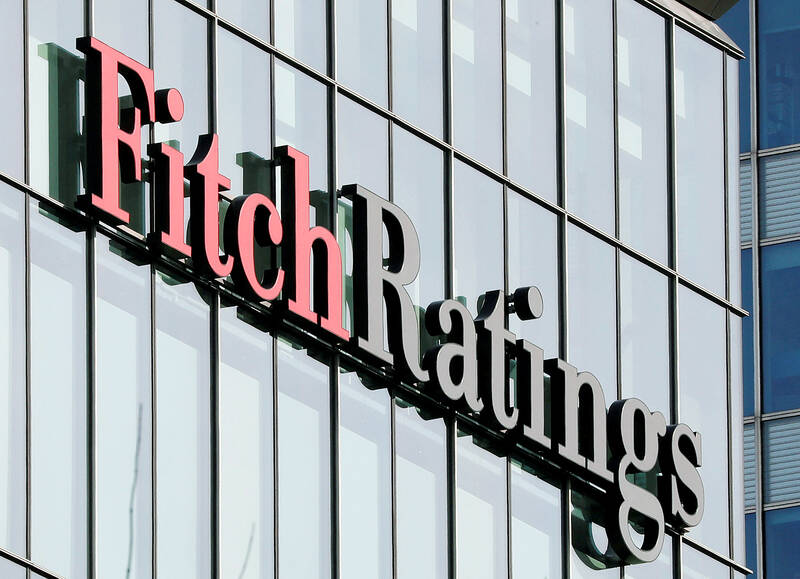The private banking sector might see modest loan growth and flat profitability this year, as monetary tightening at home and abroad help widen interest spread, boosting funding costs, Fitch Ratings Taiwan said yesterday.
“We expect Taiwan’s bank operating environment to remain stable,” Fitch credit analyst Sophia Chen (陳怡如) said, adding that the economic slowdown reflects subdued external demand for Taiwan’s electronics as well as information and communication technology products.
Fitch is projecting economic growth of 2 percent for Taiwan this year, but might trim it next month if major economic barometers fare worse than expected, Chen said.

Photo: Reuters
Taiwan’s exports and export orders both fell for an eighth consecutive month last month, slumping 13.3 percent and 18.1 percent respectively from a year earlier, official figures showed.
A recovery could take hold in the fourth quarter, allowing the economy to grow 2.5 percent next year, she said.
The Directorate-General of Budget, Accounting and Statistics in February downgraded its GDP growth forecast to 2.12 percent for this year from the 2.75 percent it predicted in November last year.
It is scheduled to announce an update of its forecast on Friday.
Still, the local banking sector enjoys a stable outlook, backed by loan growth of 5 to 6 percent, continued margin improvement and recovering fees, which might offset a rise in bad loans from relief lending to small and medium-sized enterprises during the COVID-19 pandemic, and overseas operations, Fitch credit analyst Cherry Huang (黃嬿如) said.
Taiwanese banks limit most of their lending in overseas markets to Taiwanese companies, but also take part in syndicated loans and loans to foreign clients, she said.
Foreign borrowers pose higher risks and local lenders have adopted a cautious approach as evidenced by their declining exposure in China, she said.
Bank failures in the US are unlikely to affect Taiwanese banks given their low exposure, Huang said.
The ill-fated Silicon Valley Bank, for one, is a financial partner of tech start-ups, but tech exposure is smaller than 10 percent among Fitch’s rated Taiwanese banks, she said.
The ratings agency expects the central bank to hike its policy rate by another 12.5 basis points later this year after raising it by 12.5 basis points in March and 62.5 basis points last year.
The trend has fueled money flows from demand deposits to time deposits, elevating funding costs, Huang said.
Any weakening in borrowers’ affordability due to rate increases should be limited, she said, as Taiwan’s monetary tightening is modest compared with that in the US and Europe, she said.
Low unemployment and a positive GDP should mitigate potential asset quality deterioration, despite the unwinding of relief loans over the next two years, she said.
Fitch views property assets in Taiwan as resilient, lending key support to the credit profiles of banks that have quite high property-related exposure at 36.7 percent at the end of last year, Chen said.

The US dollar was trading at NT$29.7 at 10am today on the Taipei Foreign Exchange, as the New Taiwan dollar gained NT$1.364 from the previous close last week. The NT dollar continued to rise today, after surging 3.07 percent on Friday. After opening at NT$30.91, the NT dollar gained more than NT$1 in just 15 minutes, briefly passing the NT$30 mark. Before the US Department of the Treasury's semi-annual currency report came out, expectations that the NT dollar would keep rising were already building. The NT dollar on Friday closed at NT$31.064, up by NT$0.953 — a 3.07 percent single-day gain. Today,

‘SHORT TERM’: The local currency would likely remain strong in the near term, driven by anticipated US trade pressure, capital inflows and expectations of a US Fed rate cut The US dollar is expected to fall below NT$30 in the near term, as traders anticipate increased pressure from Washington for Taiwan to allow the New Taiwan dollar to appreciate, Cathay United Bank (國泰世華銀行) chief economist Lin Chi-chao (林啟超) said. Following a sharp drop in the greenback against the NT dollar on Friday, Lin told the Central News Agency that the local currency is likely to remain strong in the short term, driven in part by market psychology surrounding anticipated US policy pressure. On Friday, the US dollar fell NT$0.953, or 3.07 percent, closing at NT$31.064 — its lowest level since Jan.

Hong Kong authorities ramped up sales of the local dollar as the greenback’s slide threatened the foreign-exchange peg. The Hong Kong Monetary Authority (HKMA) sold a record HK$60.5 billion (US$7.8 billion) of the city’s currency, according to an alert sent on its Bloomberg page yesterday in Asia, after it tested the upper end of its trading band. That added to the HK$56.1 billion of sales versus the greenback since Friday. The rapid intervention signals efforts from the city’s authorities to limit the local currency’s moves within its HK$7.75 to HK$7.85 per US dollar trading band. Heavy sales of the local dollar by

The Financial Supervisory Commission (FSC) yesterday met with some of the nation’s largest insurance companies as a skyrocketing New Taiwan dollar piles pressure on their hundreds of billions of dollars in US bond investments. The commission has asked some life insurance firms, among the biggest Asian holders of US debt, to discuss how the rapidly strengthening NT dollar has impacted their operations, people familiar with the matter said. The meeting took place as the NT dollar jumped as much as 5 percent yesterday, its biggest intraday gain in more than three decades. The local currency surged as exporters rushed to